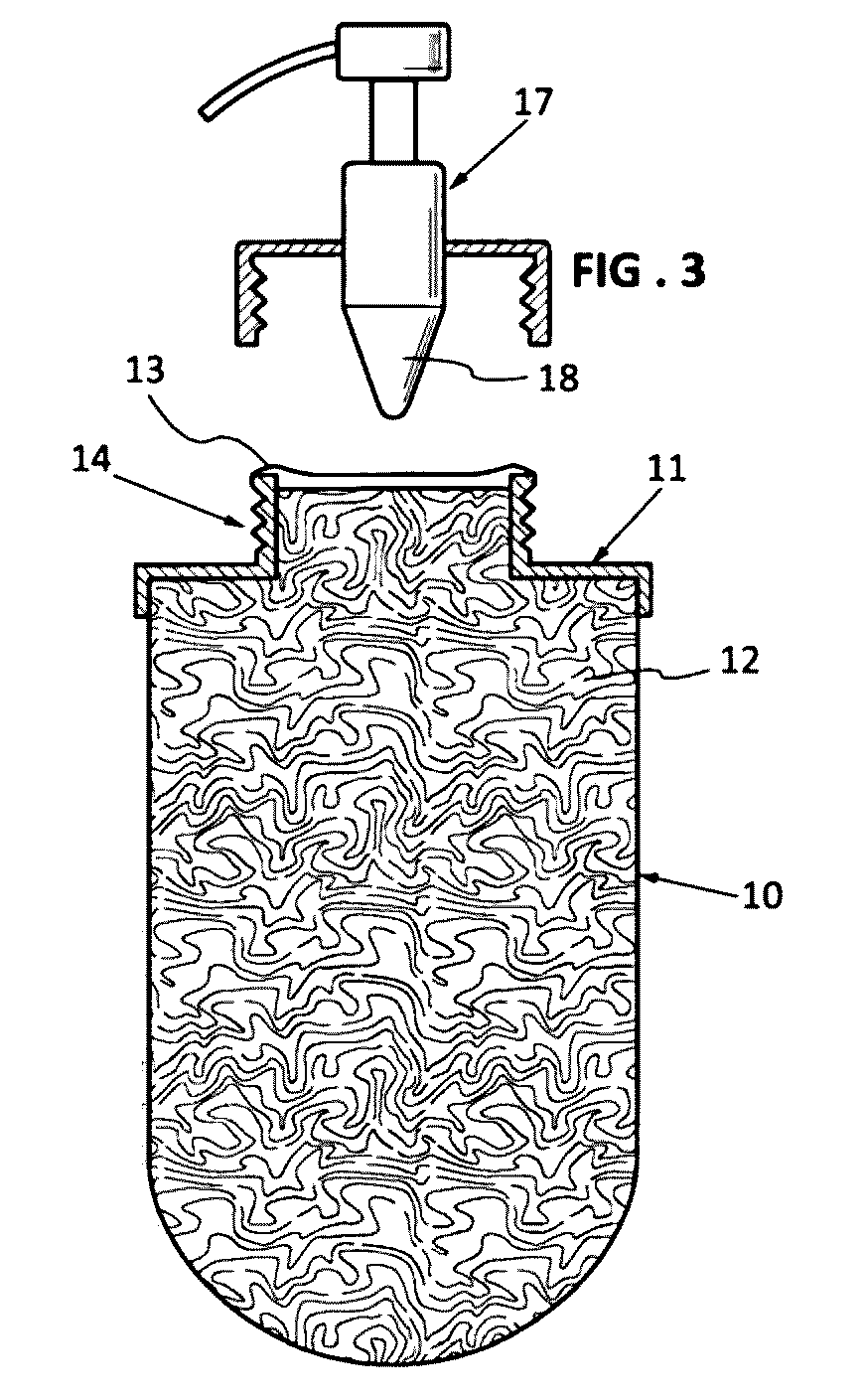Method for processing cosmetic products under high hydrostatic pressure, products obtained and suitable container
a technology of hydrostatic pressure and cosmetic products, applied in the direction of skin care, cosmetics, lavatory sanitory, etc., can solve the problems of affecting the quality of cosmetic products, destabilizing emulsions, and altering the tight structure of treated cosmetic products, so as to limit the development of microorganisms
- Summary
- Abstract
- Description
- Claims
- Application Information
AI Technical Summary
Benefits of technology
Problems solved by technology
Method used
Image
Examples
example 1
[0106]Test of Decontamination of a Cosmetic Product without any Preservative and not Treated by a Microorganism Inactivation Technique.
[0107]The effectiveness of the method according to the invention was tested on a cream based on an emulsion and without any addition of preservatives. This cream, apart from water and minority components (on the order of 5 to 6%) had a significant concentration of various lipids (vegetable oil, etc.) of more than 15%. After its formulation and its manufacture, it was placed in a non-fluid-tight container and preserved at ambient temperature for approximately 4 days.
[0108]The initial contamination observed by microbiological analysis was on the order of 3·104 UFC / g. This result demonstrated, on the one hand, the existence of an initial endogenic contamination either originating from ingredients used in the formulation or caused by handling, and, on the other hand, without any preservative, this contamination, at the end of several days, can reach a si...
example 2
Tests of Decontamination of the Same Cosmetic Product as the One of Example 1 but by Inoculating Doses of Various Microorganisms.
[0112]To evaluate the destructive effectiveness of the method according to the invention, two microorganisms have been selected for the challenge tests: a Gram+ bacterium (Staphylococcus aureus) and a mold (Aspergillus brasiliensis) that are often considered by the community of individuals in the cosmetics sector as common contaminants.
[0113]The same values of the parameters of the method according to the invention as those mentioned in Example 1 (Tests A to D) (See Table I) are applied.
TABLE IIInoculated withInoculated withNiNfEDNiNfEDTest A 1.7 × 1072.5 × 1006.81.6 × 1055.2Test B 1.7 × 1077.21.6 × 1055.2Test C 4.3 × 1045.0 × 1003.91.7 × 1055.2Test D 4.3 × 1044.61.7 × 1055.2
[0114]From the application of these tests that are representative of the method according to the invention, it is possible to conclude:[0115](i) That under the same treatment condition...
example 3
[0118]Test of the Method According to the Invention for Sterilization of Cosmetic Products on Another Cream that has Very Different Characteristics from Those Tested in Examples 1 and 2.
[0119]The tested cosmetic product is distinguished from the preceding one by the fact that no initial contamination (before any voluntary inoculation of microorganisms) has been observed.
[0120]The following table (Table III) provides treatment parameters according to the methods according to the invention that have been used.
TABLE IIIVATiP(MPa · s−1)(° C.)MA(MPa)Test E3.32012minutes400Test F3.3203 × 4minutes400Test G3.3363 × 4minutes300Test H3.3363 × 4minutes400
This product was inoculated by doses of microorganisms (challenge tests). Two types of microorganisms have been used: a Gram+ bacterium (Staphylococcus aureus) and a mold (Aspergillus brasiliensis) that are considered by the community of the individuals in the cosmetics sector as common contaminants.
[0121]The destructive effectiveness of these...
PUM
| Property | Measurement | Unit |
|---|---|---|
| pressure | aaaaa | aaaaa |
| hydrostatic pressure | aaaaa | aaaaa |
| temperature | aaaaa | aaaaa |
Abstract
Description
Claims
Application Information
 Login to View More
Login to View More - R&D
- Intellectual Property
- Life Sciences
- Materials
- Tech Scout
- Unparalleled Data Quality
- Higher Quality Content
- 60% Fewer Hallucinations
Browse by: Latest US Patents, China's latest patents, Technical Efficacy Thesaurus, Application Domain, Technology Topic, Popular Technical Reports.
© 2025 PatSnap. All rights reserved.Legal|Privacy policy|Modern Slavery Act Transparency Statement|Sitemap|About US| Contact US: help@patsnap.com



